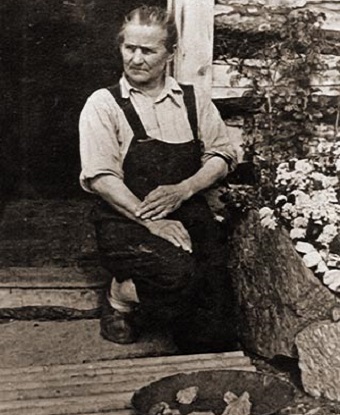Last updated: January 31, 2025
Person
Fannie Quigley

Brooker Collection, DENA 5462, Denali National Park and Preserve Museum Collection.
Born and raised on a Nebraska homestead near Wahoo, Nebraska, Frances "Fannie" Sedlacek was used to a hardscrabble life. Her parents Vencil and Josephine Sedlacek were immigrants from Bohemia. They had arrived in America in 1866 and settled in Nebraska to file a homestead claim shortly before Fannie's birth in 1870.
The 1870s and 1880s were difficult years in Nebraska. The Panic of 1873 led to a four year economic depression and falling farm prices. This was worsened with droughts, plagues of locusts, blizzards. These and other hardships from her childhood would help prepare her for life in the Alaskan frontier.
Fannie's mother died when she was six. Her father remarried soon after. He proved up on their homestead in 1875, sold it, and moved the family to a rented farm nearby.
Fannie Sedlacek left home at the age of sixteen making her way west cooking for railroad construction crews. She found her way to the Klondike gold rush stampeders.
Staking a claim in August 1900 on a stampede to Clear Creek, she met and soon married Angus McKenzie. In January, 1903, Fannie left Angus and set off on an 800 mile hike down the Yukon River ending up in Fairbanks. She made her way to the remote Kantishna Hills near Mount McKinley among the hundreds of hopeful prospectors in 1905.
Fannie arrived with a portable stove and food supplies and quickly opened for business to feed hungry stampeders. The gold proved too sparse and the population of prospectors and miners in the district. The hastily constructed community of Eureka (now Kantishna) dwindled to about 50 hardy souls. Fannie stayed filing multiple mining claims and built a life for herself.
Fannie met Joe Quigley who was one of the first to pursue lode mining in the district and together they staked and mined their claims in the area. They met in 1906, but did not officially marry until 1918. Both Fannie and Joe hunted moose, caribou, and Dall sheep for their meat and trapped marten and other animals in the winter to get furs to sell and wear. Fannie maintained large vegetable gardens and used nearby prospect tunnels for cold storage of produce and meat.
Fannie was a practicing naturalist and nurse. In 1920, during the Spanish flu pandemic, she worked at the Nenana Hospital in Nenana, Alaska.
In 1930, Joe suffered a mining injury that ended his mining career. Several years later, Joe and Fannie parted, splitting their income from the sale of their claims. Fannie stayed in Kantishna while Joe moved to Seattle.
Fannie embraced this hardworking Kantishna lifestyle for nearly 40 years dying at her home at the age of 73 on August 25, 1944. Today Fannie's yellow frame house is listed on the National Register of Historic Places. It serves as a vivid reminder of Fannie Quigley, Alaska pioneer mining legend from Denali Park and Preserve’s historic past.
For a comprehensive overview of her life, it is worth reading Searching for Fannie Quigley by historian Jane Haigh.
